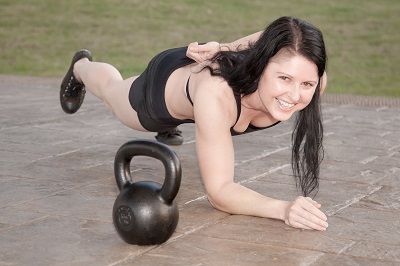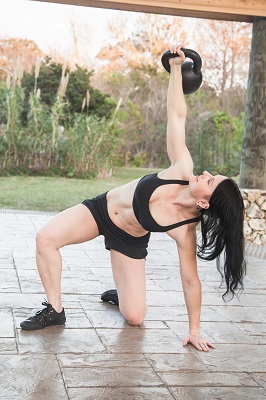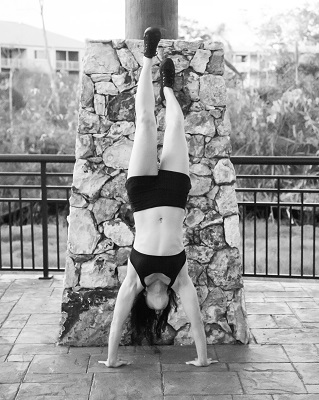
While many people have broken free of the “more is always better” idea in their bodyweight or calisthenics training, it still seems like there’s a tendency towards endless reps when it isn’t always necessary. That’s something I love about the approach to bodyweight training in Convict Conditioning, especially in the advanced progressions. I’m in maintenance mode right now (not trying to make significant changes in body composition), and am still able to acquire a lot of skill and strength with surprisingly low reps of near maximal-effort bodyweight and kettlebell drills.
Most of the time, there’s an element of spontaneity with my workouts—adapting them to the energy of the day, and making the most of it, even if that means it’s time to take a break. Also, I’ll use the time after a few days of rest to test my progress on a given move, or to establish a baseline for something I want to continue to learn. These “workouts” are often more like play. Primal Move has been a big influence on my programming—or lack thereof. My goals any more seem to be focused on the strict execution of certain moves or lifts—to the point that being able to do them on any given day in a variety of circumstances. I want to do incredible things and make it look easy, and that will only comes with patient practice.
At around 14 or 15 years old, I was in band class and remember seeing some of my good friends first learning to play the trumpet. They were trying their best, but they were making some terrible sounds. That same year, my family and I went to New Orleans and I saw a street jazz musician playing a trumpet with such ease that the trumpet might as well have been an extension of himself. He seemed to make the trumpet express whatever he wanted, however he wanted. Meanwhile back at home, my friends clumsily continued to mash what they hoped were the right combination of keys while struggling to maintain their breathing and embrasure.
Every move my friends were making was a conscious effort in this early part of their learning and obviously, a lot more practice was in order. The practiced ease and confidence of a professional musician, acrobat, or other performer is something that I greatly admire. The accomplished street performer who consistently delivers amid constantly changing and chaotic conditions demands equal admiration.

The three stages of motor learning—cognitive, associative, and autonomous certainly apply to our training. In the cognitive stage every part of the movement or skill someone is learning is very conscious, right foot here, left foot there, etc. Sometimes people go through a mental checklist in this stage, every (remembered) detail is a conscious effort. In bodyweight exercise, during the cognitive stage we are also beginning to gain the necessary strength, along with figuring out where all our “parts” need to go! The first few times I tried to do a clutch flag I had to check and make sure my hands were facing the right directions on the pole, really think about which parts were on which side, what was stacked, where was the weight going, what needed to be tensed to the max. Now I can walk up to an appropriate parking pole and casually just pop up into a clutch flag because I’m well past the cognitive stage. Now that I’m learning the press flag, or “human flag,” I’m having to once again learn which hand goes where on the pole, where I’m facing… The process has started all over again—and that’s before getting to the strength components. (By the way the progressions for the clutch flag and press flag in Convict Conditioning 2 are just fantastic.) From the previous paragraph, my teenage friends were still in the cognitive stage, and the jazz musician in New Orleans was fully autonomous.
Generally speaking, when our form on a move gets sloppy, we are not learning, and our body and minds are in a self-protective mode. In most cases, this will lead to decreased performance with a greater risk of injury. Its so important especially with bodyweight exercise to remember that some of the moves can be near-maximal exercises. Without a barbell loaded up and bending in the middle, or a giant kettlebell to remind us, it can be easy to forget that we’re near our max—for muscles and the central nervous system. Keeping reps low, and staying fresh by taking necessary breaks (or supersetting non-related exercises) has been absolutely central to my own success. Just doing a few near maximal lifts or intense short sets throughout the day can be amazingly effective. It’s like making a small deposit in a savings account, which over time—and often more quickly than expected—really starts to add up. It helps to be dedicated, and it really helps to be a little stubborn!
Something I’ve been asked a number of times by people interested in bodyweight training is, “What do you do about injuries?” It sounds like a smart aleck answer, so I always try to phrase it politely, but what I really want to say in those situations is, “I just try not to have them in the first place, by stopping before it gets ugly.”
As a general rule, if I finally accomplish a goal exercise (a dead hang bar muscle-up is a good example), depending on how it felt, I might just stop right there and take a break. Regardless of where you are in terms of strength or skill, pushing a maximal move to exhaustion usually leads to some unpleasant consequences. I don’t want a potential injury or the lost training time that comes with it. An extra rep or two isn’t worth the risk. Besides, with a lifestyle which includes leading workshops, local classes, plus my own training, I simply can’t afford to take injury risks. Pretty sure your lifestyle doesn’t have room for needless injury either. I think, part of the learning curve with skillful exercise involves learning your own limits, and safely expanding those limits over time.
***
About Adrienne Harvey, RKCII, CK-FMS, Primal Move Nat’l Instructor: I started studying kettlebell training over three years ago and became RKC Certified in October of 2010, and became an RKC Level 2 Instructor in July 10th of 2011. Kettlebell and bodyweight training have been absolutely crucial in my personal quest for fitness, and I love sharing these ultra-effective modalities with small groups and individuals. Similarly, developing recipes to further support performance, body composition, and general enjoyment is another passion. Go to http://www.giryagirl.com/ for more information about Adrienne!


